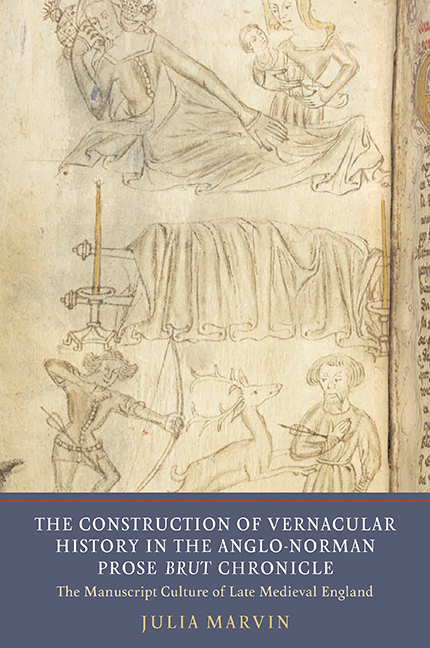 The Construction of Vernacular History in the Anglo-Norman Prose Brut Chronicle
The Construction of Vernacular History in the Anglo-Norman Prose Brut Chronicle Book contents
- Frontmatter
- Dedication
- Content
- List of Plates
- Acknowledgments
- Abbreviations
- A Note on Proper Names, Transcriptions, and Translations
- Introduction: Recognizing the Prose Brut Tradition
- Part I Construction
- Part II Reconstruction and Response
- 6 Evidence of Production
- 7 The Company That Prose Bruts Keep
- 8 Ordinatio, Apparatus, and Annotation
- 9 History Illustrated
- Conclusion: Merlin's Power
- Bibliography
- General Index
- Index of Manuscripts Cited
9 - History Illustrated
from Part II - Reconstruction and Response
Published online by Cambridge University Press: 01 February 2018
- Frontmatter
- Dedication
- Content
- List of Plates
- Acknowledgments
- Abbreviations
- A Note on Proper Names, Transcriptions, and Translations
- Introduction: Recognizing the Prose Brut Tradition
- Part I Construction
- Part II Reconstruction and Response
- 6 Evidence of Production
- 7 The Company That Prose Bruts Keep
- 8 Ordinatio, Apparatus, and Annotation
- 9 History Illustrated
- Conclusion: Merlin's Power
- Bibliography
- General Index
- Index of Manuscripts Cited
Summary
Illustration is another kind of supplementation that is difficult to appreciate outside the physical context of the manuscript. Like apparatus and annotation, it resists simple definition. Illustrations may provide decoration, ways of demonstrating the status of the work – iconographically and/or economically – and pointers towards interpretation. They may do as much to test or question the text they accompany as they do to repeat its content in another form, as a variety of apparatus that helps guide readers through the work in question and assigns extra significance to particular moments by singling them out for attention. They are limited to manuscripts with some space to spare and, for the most part, commissioners with money to spare. In addition to serving the function of apparatus, they of course constitute works in their own right: such study as Anglo-Norman prose Brut illustrations have received has generally been in isolation from the textual context. They are found rarely throughout the prose Brut tradition, and among Anglo- Norman prose Brut manuscripts only in a very few insular manuscripts and the three late luxury manuscripts produced on the Continent. Although, as Martha Driver and Michael Orr note, there appears to have been a drive towards standardization of illustrative matter in the late fourteenth and fifteenth centuries, the surviving illuminations in Anglo-Norman prose Brut manuscripts do not suggest much in the way of a iconographic tradition.
Insular Illustrations
The manuscripts with illustrations are among the most highly decorated of the insular Anglo-Norman prose Bruts, although not themselves particularly fine or lavish productions. Unsurprisingly, their illustrations appear at the beginning of the chronicle and are the manuscripts’ most extravagant feature. In the two manuscripts with the Latin poem encapsulating the post- Conquest kings’ reigns, one (RD329) has a completed, colorful set of king portraits and genealogies and the other (P511/19) space for such portraits; after this emphatic triple gesture directing the reader – via words, images, and diagrams – to think of British history as a series of genealogically linked portraits, an approach much akin to that of the Oldest Version's narrative, the Albine prologue and Brut chronicle are marked only with nicely made large initials.
- Type
- Chapter
- Information
- The Construction of Vernacular History in the Anglo-Norman Prose Brut ChronicleThe Manuscript Culture of Late Medieval England, pp. 205 - 230Publisher: Boydell & BrewerPrint publication year: 2017
